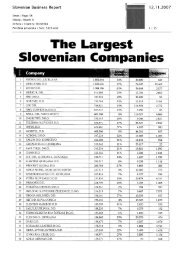The Group KD Group and KD Group dd
The Group KD Group and KD Group dd
The Group KD Group and KD Group dd
You also want an ePaper? Increase the reach of your titles
YUMPU automatically turns print PDFs into web optimized ePapers that Google loves.
<strong>The</strong> <strong>Group</strong> <strong>KD</strong> <strong>Group</strong> Annual Report 2009<br />
Notes to Consolidated Financial Statements as at <strong>and</strong> for the year ended 31 December 2009<br />
Types of risks<br />
5.1 Insurance risk<br />
Risk related to the insurance policy represents the possibility that the event insured against actually occurs <strong>and</strong> uncertainty in<br />
relation to the amount of the sum insured or indemnity. It is the nature of insurance contracts that insurance risks are<br />
incidental <strong>and</strong> unpredictable; however, the main risk for the insurer is the possibility that claims <strong>and</strong> benefits exceed the<br />
amount of insurance liabilities (technical provisions) created for a portfolio of insurance contracts using statistical methods.<br />
This may happen because of a change in the frequency of claims or their amount, which can be higher than expected.<br />
Insured events are incidental, which means that their number <strong>and</strong> amount vary in individual years <strong>and</strong> in relation to<br />
statistically established averages. Experience shows that the larger the portfolio of similar insurance contracts, the smaller the<br />
relative variability of the expected outcome will be. In a<strong>dd</strong>ition, a more diversified portfolio is less likely to be affected by a<br />
change in any subset of the portfolio.<br />
Insurance companies in the <strong>Group</strong> have developed their own policy of concluding insurance contracts with the aim of<br />
spreading the assumed risks <strong>and</strong> achieve, within each individual category, a sufficient amount of risk population to reduce the<br />
variability of expected results. <strong>The</strong> principal means for reducing insurance risks is reinsurance, i.e. the transfer of risks that<br />
exceed a predetermined amount to a reinsurance company.<br />
When developing a new insurance product, it is very important that the parameters defining the insurance premium are<br />
assessed adequately. <strong>The</strong> risk accepted by the <strong>Group</strong> at the inception of an insurance contract is reflected in the price, i.e.<br />
the insurance premium. If the parameters defining the insurance premium are not assessed adequately when developing a<br />
new insurance product, this is a risk for the <strong>Group</strong> to which it is exposed during the entire life cycle of the insurance product.<br />
In the context of insurance risk, the <strong>Group</strong> is exposed to underwriting process risk, product design risk, pricing risk, economic<br />
environment risk, policyholder behaviour risk, reserve risk <strong>and</strong> claims risk. Insurance risks are also managed with reinsurance<br />
protection.<br />
5.1.1 Description of risks<br />
Insurance activities are based on managing insurance risks. Insurance risks apply to risks accepted by the insurer from the<br />
policyholder. Insurance risks are r<strong>and</strong>om <strong>and</strong> unpredictable. At the signing of an insurance contract, the insurer accepts the<br />
risk to repay the insured the agreed contractual amount if an insured event occurs or if the contract expires, whereas when<br />
the insured event will occur is uncertain.<br />
Insurance cases are r<strong>and</strong>om; their number <strong>and</strong> amounts vary from year to year <strong>and</strong> deviate from statistical averages. <strong>The</strong><br />
<strong>Group</strong> is therefore engaged in diversifying <strong>and</strong> increasing its portfolio. This allows it to disperse the risk <strong>and</strong> lower the<br />
variability of expected events. An important instrument to lower insurance risks is reinsurance, i.e. the transfer of risks which<br />
exceed a predetermined amount to a reinsurer. <strong>The</strong> <strong>Group</strong> further manages insurance risks through the effective performance<br />
of internal controls, internal audits <strong>and</strong> forming appropriate insurance technical provisions to cover potential future liabilities<br />
stemming from existing insurance contracts.<br />
In the management’s opinion, the important risks faced by the <strong>Group</strong> in its operations are the following:<br />
- Underwriting process risk, the danger of misevaluation of accepted risk. This risk involves mistaken decisions to<br />
underwrite a risk regardless of the risk exposure of the insured, insurance on the basis of inaccurate <strong>and</strong> incomplete<br />
information on the insured, incorrect information about the amount of maximum potential claims, or potential inappropriate<br />
acquisition of reinsurance coverage by the reinsurer.<br />
<strong>The</strong> <strong>Group</strong> manages the aforementioned risk through providing guidelines for accepting insurance risks, using software for<br />
accepting insurance risks, <strong>and</strong> strict criteria <strong>and</strong> procedures for accepting insurance risks, especially for large insured sums<br />
<strong>and</strong> coverage. Also, the <strong>Group</strong> has concluded an obligatory reinsurance contract with its reinsurer, by which the reinsured<br />
risks over a certain contractually agreed insured sum are automatically reinsured. <strong>The</strong> <strong>Group</strong> also monitors claims outcome<br />
<strong>and</strong> analyses any worsening thereof.<br />
- <strong>The</strong> risk of inadequate assessment of liabilities stemming from insurance contracts (reserve risk) is the risk that these<br />
reserves will not be adequate to cover the liabilities stemming from accepted risks, or the risk that future claims payments will<br />
exceed the evaluated amount of liabilities.<br />
111







